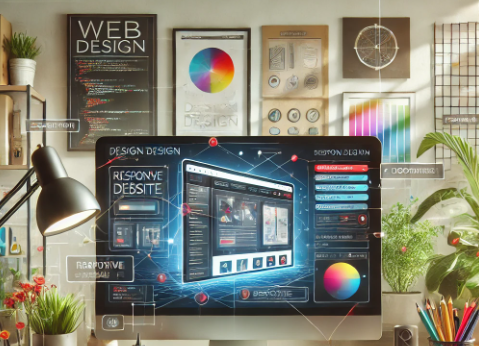Web design is more than just creating visually appealing websites; it’s about crafting a user-friendly experience that effectively communicates a brand’s message. Whether you are a seasoned designer or a business owner looking to enhance your online presence, understanding the core principles of web design can significantly impact your website’s success. For those seeking professional web design services, visiting mightymegaphone can be a great start.
Understanding the Core Elements of Web Design
A well-designed website is a balance between aesthetics and functionality. Let’s dive into the key elements that contribute to a successful web design:
1. Visual Hierarchy
Visual hierarchy is the arrangement of elements on a webpage in a way that guides the user’s attention to the most important parts first. This is achieved through size, color, contrast, and spacing. For instance, headlines are often larger and bolder than body text to immediately grab attention.
2. Responsive Design
With the growing use of mobile devices, responsive design has become a necessity. A responsive website adjusts its layout and content to fit various screen sizes, ensuring a seamless user experience across all devices. Neglecting responsiveness can lead to a high bounce rate and lost conversions.
3. Navigation
Navigation is the roadmap of a website. It should be intuitive and easy to use. A well-structured navigation menu helps users find what they’re looking for quickly, enhancing the overall user experience. Dropdown menus, breadcrumb navigation, and search bars are some tools to improve navigation.
4. Typography
Typography plays a vital role in web design by affecting readability and user engagement. Choosing the right fonts and maintaining a consistent typographic style across the website can make a significant difference in how users perceive the content.
5. Color Scheme
Colors evoke emotions and set the tone for the website. A well-thought-out color scheme can strengthen brand identity and create a cohesive look. It’s essential to maintain contrast between text and background to ensure readability.
6. Content
Content is the backbone of any website. It should be relevant, engaging, and well-structured. Incorporating headings, subheadings, bullet points, and visuals can break up large chunks of text, making the content more digestible.
Trends in Modern Web Design
Web design trends evolve constantly, influenced by technological advancements and user preferences. Staying updated with these trends can help designers create more engaging and innovative websites.
1. Dark Mode
Dark mode has gained popularity for its sleek appearance and energy-saving benefits. It reduces eye strain and makes the website stand out, especially in low-light environments.
2. Minimalism
Minimalist design focuses on simplicity and functionality. By eliminating unnecessary elements, designers can create clean and efficient websites that emphasize the core message.
3. Micro-Interactions
Micro-interactions are small animations or responses triggered by user actions, such as clicking a button or hovering over an image. These interactions enhance user engagement and make the website more interactive.
4. Voice User Interface (VUI)
With the rise of voice assistants, integrating VUI into websites can improve accessibility and provide a more convenient browsing experience.
5. 3D Elements
Incorporating 3D elements and animations can make a website more dynamic and visually appealing. However, it’s crucial to ensure that these elements do not affect the website’s performance.
Best Practices for Effective Web Design
Creating a successful website requires more than just implementing the latest trends. Here are some best practices to keep in mind:
1. Prioritize User Experience (UX)
User experience should be at the forefront of web design. Understand your audience’s needs and preferences to create a website that offers value and satisfaction.
2. Optimize Loading Speed
Website loading speed is a critical factor in user retention. Slow-loading websites can frustrate users and lead to a high bounce rate. Use optimized images, leverage browser caching, and minimize code to improve speed.
3. Ensure Accessibility
Web accessibility ensures that people with disabilities can use the website effectively. Implementing features like alt text for images, keyboard navigation, and proper heading structures can improve accessibility.
4. Maintain Consistency
Consistency in design elements, such as fonts, colors, and button styles, helps create a cohesive look and feel. It also improves user familiarity and trust.
5. Test and Iterate
Web design is an ongoing process. Regularly test your website for usability, performance, and security. Gather feedback from users and make necessary improvements to enhance the overall experience.
Conclusion
Web design is an ever-evolving field that combines creativity with technical expertise. By understanding the core elements, staying updated with trends, and following best practices, you can create websites that not only look great but also provide an exceptional user experience. Whether you are designing a website from scratch or revamping an existing one, remember that a user-centric approach is key to success. For professional guidance, consider exploring resources like mightymegaphone to elevate your web design projects.



